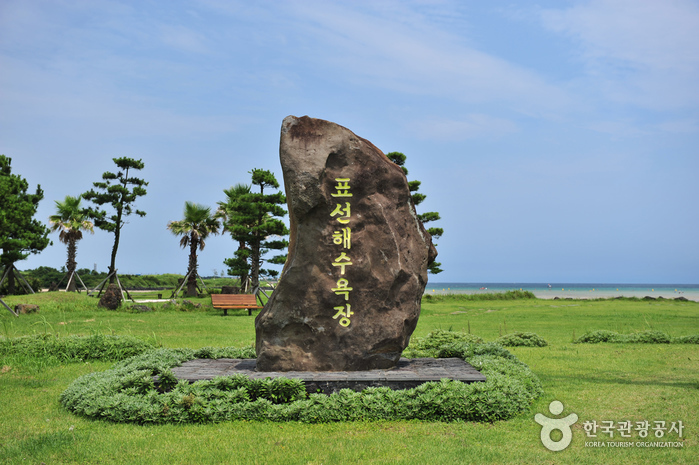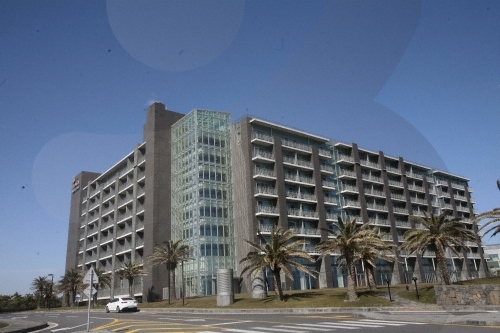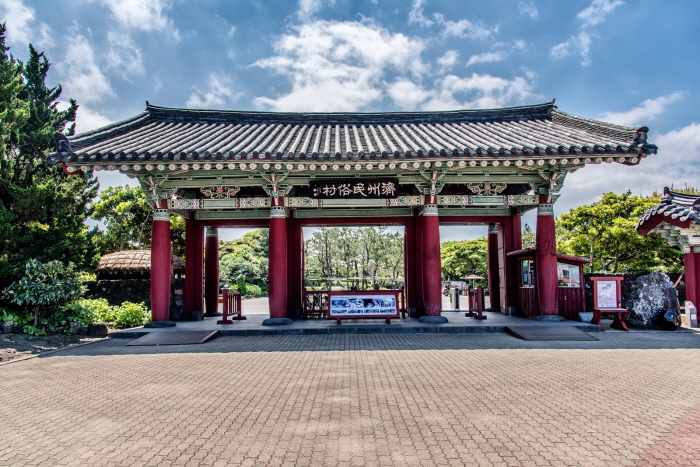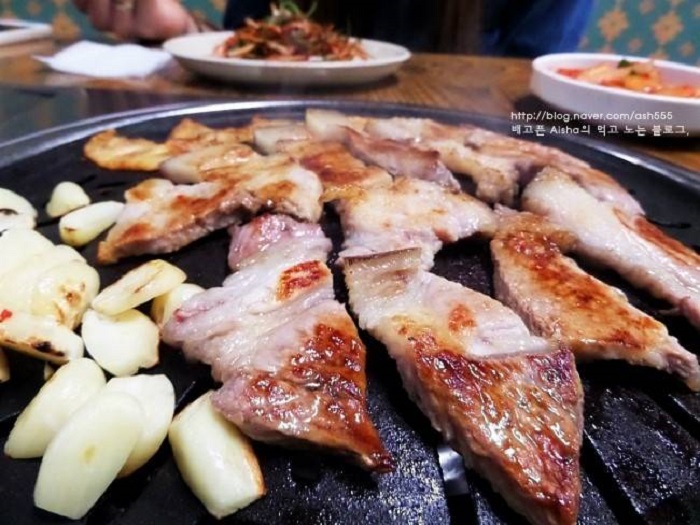Woljeongri Beach (월정리해변(월정리해수욕장))
15.8Km 30958 2023-01-17
480-1, Haemajihaean-ro, Jeju-si, Jeju-do
+82-64-740-6000
Woljeong-ri, a village located on the east side of Jeju Island, holds the meaning "the moon stays." The beautiful emerald sea spreads out like a picture, and the bright moon shines above it. As more and more travelers visited the beach to appreciate its beauty, many restaurants, cafes, and lodging facilities started to form along the shoreline. Some cafes placed chairs for people to relax in while looking at the sea, which became an iconic photo spot of Woljeongri Beach.
The beach is also a popular location for a variety of water sports such as surfing, snorkeling, and kayaking. Woljeongri Beach is popular among surfers because it has waves with a uniform x_height that are constantly coming in. The beach is also a part of the Gimnyeong-Hado Olle and Gimnyeong-Woljeong Geotrail Course on Jeju Olle Trail Route 20, and a great spot for tourists to take a break while taking in the beautiful scenery and cool scent of the sea.
Manjanggul Lava Tube [National Geopark] (만장굴 (제주도 국가지질공원))
16.2Km 237725 2024-05-17
182, Manjanggul-gil, Jeju-si, Jeju-do
+82-64-710-3945
Manjanggul Lava Tube, located in Gimnyeong-ri, Jeju, is part of the Geomunoreum Lava Tube system. The lava tube stretches roughly 7,400 meters, with a maximum x_height of 25 meters and x_width of 18 meters. These measurements make it one of the largest lava tubes in the world. Manjanggul holds great value for science and conservation studies, having well-maintained formations despite being formed over one hundred thousand years ago.
The majority of the cave is closed off, with only 1 kilometer being open to tourists. Within this open section, visitors can see a variety of lava tube and cave topographical features, including stalagtites, stalagmites, and stone pillars. Among these, the 7.6-meter-tall stone pillar at the end of the open section is recorded as the largest in the world.
Gimnyeong Maze Park (김녕미로공원)
16.6Km 94709 2024-03-13
122 Manjanggul-gil, Gujwa-eup, Jeju-si, Jeju-do
+82-64-782-9266
Gimnyeong Maze Park is intricately designed with towering evergreen trees, each reaching up to three meters in x_height, creating an natural labyrinth. The pathways are paved with scoria, a natural volcanic rock characteristic of Jeju, enhancing the authentic island feel. As visitors navigate the maze, the refreshing scent of evergreen trees fills the air, providing a sense of clarity and rejuvenation. Along the route, visitors can encounter unique dolmens and their feline residents. The park also features an observatory and a suspension bridge, offering breathtaking panoramic views. Gimnyeong Maze Park is a favorite destination for families, children and couples alike, providing a memorable experience for all.
Gimnyeongsagul Cave [UNESCO World Heritage] (김녕사굴 [유네스코 세계자연유산])
16.8Km 21046 2022-12-29
34, Manjanggul-gil, Jeju-si, Jeju-do
+82-1600-0064
Gimnyeongsagul Cave is located close to Manjanggul Cave in the northeastern part of Jeju Island. The name of the cave, "Sagul," comes from the snake-like formation of the cave ("sa" meaning serpent). The entrance of the cave is wide like a serpent holding its mouth wide open, but once inside, the tunnel narrows resembling the body of a snake. Gimnyeongsagul Cave is a highly protected area and has been designated as Natural Monument along with Manjanggul Cave.
Yongcheondonggul Cave [UNESCO World Natural Heritage Site] (용천동굴 [유네스코 세계자연유산])
16.8Km 24114 2020-11-27
Woljeong-ri, Jeju-si, Jeju-do
+82-1600-0064
Yongcheondonggul Cave is the most typical form of lava tunnel on Jeju Island and with a total length of approximately 2,470 meters, it is one of the largest. It has a unique topology and rich limestone formations such as lava terrace, lava shelves, lava waterfalls, and 140 meters of lava rolls. In particular, a range of carbonate formations such as straw soda, stalactite, columns, flowstones, cave corals, and aragonite crystals can be found inside this large cave that also contains a lake. This unique cave is astounding in terms of its geological value and beauty. There are also items that can be found throughout the cave that appear to have been brought in by people who lived on the island long ago, such as pieces of pottery, animal bones, ironware, charcoal and other substances.
* The UNESCO World Heritage inscribed Geomunoreum Lava Tube System consists of Bengdwigul, Manjanggul, Gimnyeonggul, Yongcheondonggul and Dangcheomuldonggul Caves.
Dangcheomuldonggul Cave [UNESCO World Natural Heritage Site] (당처물동굴 [유네스코 세계자연유산])
16.9Km 20850 2020-04-23
Woljeong-ri, Gujwa-eup, Jeju-si, Jeju-do
+82-1600-0064
Dangcheomuldonggul Cave, located in Jeju, is a lava tube estimated to have been formed some 320,000 years ago due to volcanic activity; it is located approximately 3 kilometers underground. With no entrance as such, the cave is not open to the general public and thus its original form remains preserved to this day, giving it a high geological value.
Although the Dangcheomuldonggul Cave is technically a lava tube, it resembles a limestone cave due to the secondary geological formations
of lime substances that have accumulated in the ground above the tube. The tunnel has a spectacular and mystical beauty with countless stalactites and stalagmites, as well as stalactite columns. The particularly thin stalactites and stalactic columns in this cave are well-known for their uniqueness and beauty. Although this is a relatively small lava tunnel, its exotic colors and the richness of the secondary topological formations make it extraordinary in terms of research value. This cave has been designated natural monument.
* The UNESCO World Heritage inscribed Geomun Oreum Lava Tube System consists of Bengdwigul, Manjanggul Cave, Gimnyeonggul, Yongcheondonggul and Dangcheomuldonggul Caves.
Pyoseon Haevich Beach (표선 해비치 해변)
17.2Km 30790 2021-12-25
Minsokhaean-ro, Seogwipo-si, Jeju-do
+82-64-740-6000
Pyoseon Beach in Seogwipo is a spacious beach, taking up more than 150,000 m². During low tide, the beach looks like an elegant circle, and it becomes a circular lake less than 1 meter deep during high tide, and displays many different colors. The beach is a great place for children to play and for watching the sunrise. The sand on the beach is formed out of broken shells, and sand baths are believed to be effective for people suffering from neuralgia. Every August, this beautiful beach hosts the Pyoseon White Sand Festival, which offers fun and colorful events. The beach is equipped with excellent amenities (a campground, abundant parking space, dressing rooms and shower rooms) and surrounded by nearby attractions, such as Seongeup Folk Village and Jeju Folk Village Museum.
Haevichi Hotel (해비치 호텔)
17.4Km 23016 2021-06-09
537, Minsokhaean-ro, Seogwipo-si, Jeju-do
+82-64-780-8100
Haevichi Hotel & Resort, a deluxe 5-star hotel in Jeju that opened on
May 24th, 2007, is a subsidiary of Hyundai Motor Group. The place has a total of 503 guest rooms (288 rooms in the hotel, 215 in resort) and is located in Pyoseon where the folk culture and the nature are well-preserved. As the nearest hotel to the beach, around 70% of the hotel’s guest rooms have a gorgeous ocean view. The hotel room is around 47 square meters, the largest in size in the country. Every guestroom has a king-sized bed offering the most comfortable and quality accommodation for the guests.
The hotel also has 6 ballrooms, big and small, which when combined, offers the biggest capacity in Jeju as a
single hotel accommodating 14 different conferences and 2,740 people at the
same time. Other facilities include a café, bar, fitness center, swimming
pools, a winter garden, a spa, and such high-end restaurants as Summora, Hanoru, Iidy and Bar 99.
Jeju Folk Village (제주민속촌)
17.5Km 96866 2024-03-11
631-34, Minsokhaean-ro, Pyoseon-myeon, Seogwipo-si, Jeju-do
+82-64-787-4501
Jeju Folk Village reproduces the old life of Jeju in the 19th century. More than 100 traditional Jeju houses and folk culture are being recreated and exhibited through archival research. The village is planted with local trees and flowers from Jeju and Korea, so visitors can enjoy flowers in all seasons. It features themed exhibition halls, model houses, and traditional folk games, attracting numerous visitors.
Namokdo Sikdang (나목도식당)
18.7Km 48 2021-03-24
60, Gasi-ro 613beon-gil, Seogwipo-si, Jeju-do
+82-64-787-1202
This is a restaurant of Duruchigi (Korean stir-fried pork) that is frequently visited by locals in Jeju. This Korean dishes restaurant is located in Seogwipo-si, Jeju-do. The representative menu is stir-fried pork.

![Manjanggul Lava Tube [National Geopark] (만장굴 (제주도 국가지질공원))](http://tong.visitkorea.or.kr/cms/resource/04/2658504_image2_1.jpeg)
![Gimnyeongsagul Cave [UNESCO World Heritage] (김녕사굴 [유네스코 세계자연유산])](http://tong.visitkorea.or.kr/cms/resource/37/1618237_image2_1.jpg)




 English
English
 한국어
한국어 日本語
日本語 中文(简体)
中文(简体) Deutsch
Deutsch Français
Français Español
Español Русский
Русский